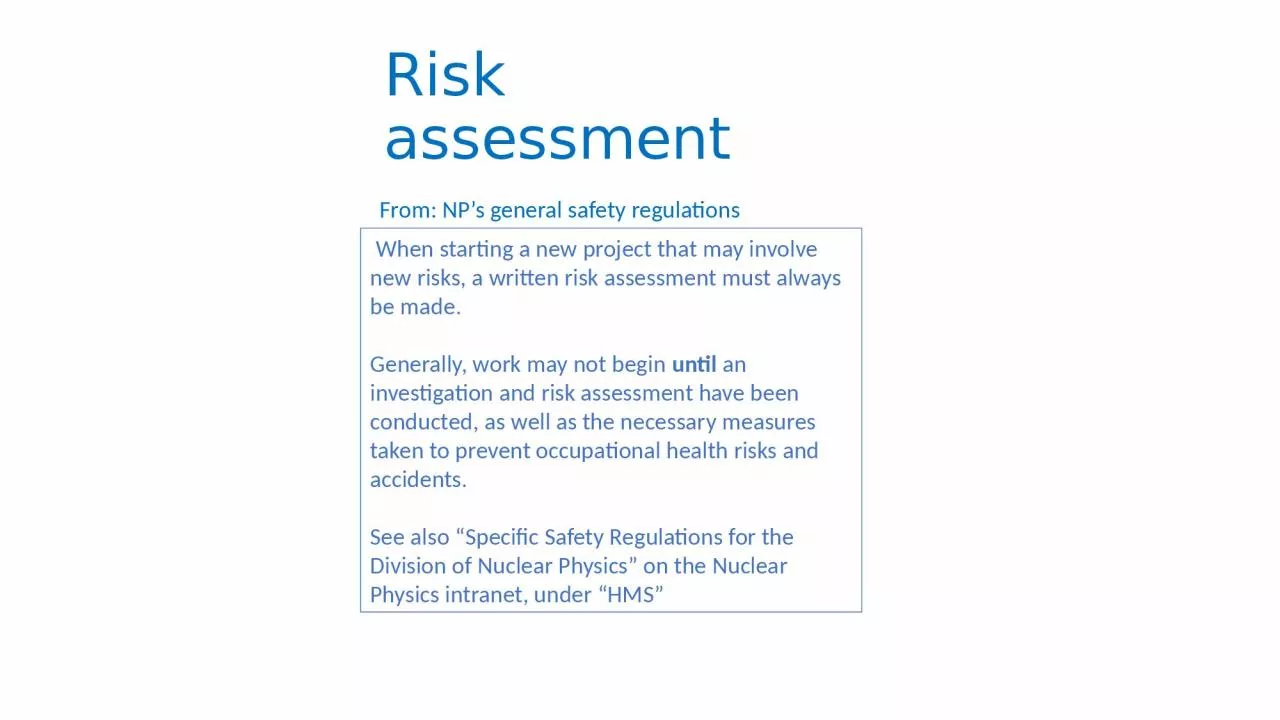

Generally work may not begin until an investigation and risk assessment have been conducted as well as the necessary measures taken to prevent occupational health risks and accidents See also Specific Safety Regulations for the Division of Nuclear Physics on the Nuclear Physics intran ID: 1022699
Download Presentation The PPT/PDF document "Risk assessment When starting a new p..." is the property of its rightful owner. Permission is granted to download and print the materials on this web site for personal, non-commercial use only, and to display it on your personal computer provided you do not modify the materials and that you retain all copyright notices contained in the materials. By downloading content from our website, you accept the terms of this agreement.
1. Risk assessment When starting a new project that may involve new risks, a written risk assessment must always be made. Generally, work may not begin until an investigation and risk assessment have been conducted, as well as the necessary measures taken to prevent occupational health risks and accidents. See also “Specific Safety Regulations for the Division of Nuclear Physics” on the Nuclear Physics intranet, under “HMS”From: NP’s general safety regulations
2. Risk assessmentFrom: NP’s special safety regulations Risk assessment should be carried out in all cases where there is a risk of occupational injury, but also in other cases, for example, the risk of theft and computer hacking. Risk assessment must be carried out for each doctoral project and for laboratory practicals in undergraduate teaching. The Head of Division is responsible for ensuring risk assessments are carried out, and he or she should be able to be present them to the Head of Department.
3. Risk assessmentUpdate to be implemented in NP’s specific safety regulatoinsRisk assessments are to be carried out for all laboratory activities, as described below. 1. When starting a new project that may be associated with significant new risks, a written risk assessment of the project must always be made. This risk assessment is only valid for 1 year, and must then be updated. Material data sheets must not be older than 3 years when the risk assessment is made. 2. Risk assessment of laboratory operations should normally be made by the person who is to perform the work and in the system for management of chemicals KLARA. If there is a change in personnel, a new risk assessment should normally be made. Contact Mattias Olsson regarding the risk assessment of chemical hazards. Risk assessments are to be reviewed by Mattias Olsson and approved by the Head of Division before work commences. Contact Mikael Elfman regarding the risk assessment of ionizing radiation hazards. Risk assessments are to be reviewed by Mikael Elfman and approved by the Head of Division before work commences. 3. When the risk assessment is made by someone other than the person who is going to perform the work, the person making the risk assessment is responsible for ensuring that the person who will carry out the work has read and understood the risk assessment, signs a declaration to this effect, and agrees to comply with the measures set out in the risk assessment. 4. The original is to be kept by the Head of Division. 5. A copy is to be kept so that it is readily accessible in the area in which the work is being carried out.
4. Mangement of risk assessments at NP4Group leader or other senior reviews.Group leader/ senior signs!5HMS- Head of div (Kristina) +Head of Div (Erik)Head of Div signs! 1Each coworker:Risk assessment of laboratory activitySign!2If chemicals are involved, via Mattias Olsson for review and approvalMattias signs!Feedback, copy to coworkerAccessible copy of approved risk assessment is kept where work is being carried outOriginal is kept at Head of Division This prodecure applies from new risk assessments from 2021-05-07. Before any work involving significant risks starts, a riskassessment must be done and must be approved.May presently be done electronically due to Covid restrictionsAt work performed outside of the Division premises (e.g. aerosol lab): Copy of risk assessment, approved according to the routines at the lab, is sent to NP Head of Division3If ionizing radiation is involved, via Mikael Elfman for review and approvalMikael signs!
5. Example risk assessmentExamine working conditions and identify the sources of risk and risk factors. Assess the sources of the risk identified. State whether the risk is serious or not. Clarify who is responsible for the measures to be taken, when they should be implemented, and a follow-up date or occasion. Implement the measures. Make an action plan for what is not implement immediately. Follow the guidelines and measures to be taken from the Lund University and LTH. Check if the measures have had an effect. Risk descriptionImpact descriptionImpact assessmentNegligible/Moderate/SeriousProbabilityLow/Medium/HighProposed measures to reduce the risk Person responsibleOtherExposure to ionizing radiation using low-activity radioactive sources at laboratory excercisesRisk of high exposure of ionizing radiation, leading to health effectsModerate/SeriousLow (that exposure limits are exceeded)Estimate dose rate before handling the sourceUse proper radiation shielding at all timesUse dosimeterUse forecepts at handling the sourceMaximize distance between source and personMinimize time of exposureWash hands when leaving labNo eating or drinking int the lab Relevant if chemical risks involvedRelevant if ionizing radiation risks involvedDateSignatureNameMattias OlssonMikael ElfmanErik SwietlickiRoleEmployeeChemistry functionIonizing radiation functionGroup leaderHead of Division